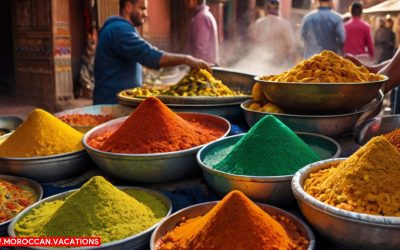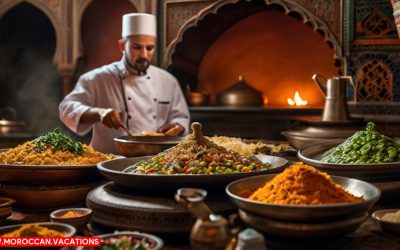The History and Influence of Moroccan Cuisine
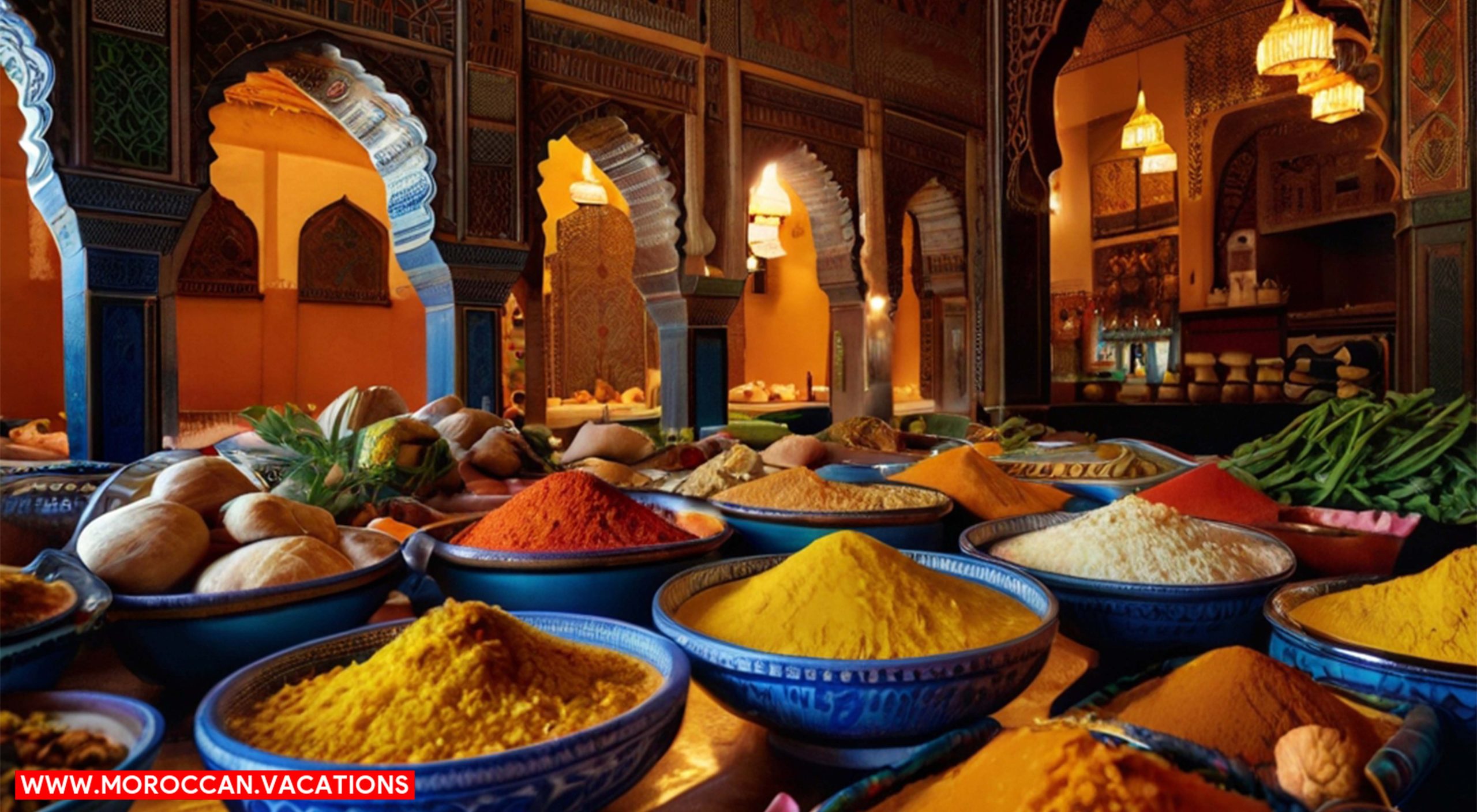

Experience the vibrant food culture of Marrakesh through cooking classes and unlock the secrets of Moroccan cuisine. Did you know that Marrakesh is home to over 12,000 food stalls and restaurants? Immerse yourself in the bustling food markets, where the aroma of exotic spices fills the air. Learn traditional recipes like tagines and couscous, and discover the art of Moroccan spices and flavors. Connect with local chefs and food enthusiasts, and master the techniques and tips for authentic Moroccan cooking. Get ready for a culinary adventure like no other.
If you want to understand the vibrant food culture of Marrakesh, you must delve into the history and influence of Moroccan cuisine. Marrakesh, the bustling city in Morocco, is known for its rich culinary traditions that have been shaped by a long and fascinating history. The history and culture of Morocco have greatly influenced its cuisine, making it a unique blend of flavors and spices.
Moroccan cuisine has a deep-rooted history that stretches back centuries. The Berbers, who are the indigenous people of North Africa, have played a significant role in shaping Moroccan culinary traditions. Their nomadic lifestyle and close connection to the land have influenced the use of ingredients such as couscous, lamb, and various spices.
Over the years, Morocco has been influenced by various cultures and civilizations, including the Arabs, Moors, and French. Each of these influences has left a mark on Moroccan cuisine, resulting in a diverse and exciting array of dishes. The flavors of Morocco are a fusion of sweet and savory, with dishes often incorporating ingredients like dates, almonds, saffron, and cumin.
The culinary traditions of Marrakesh reflect the city’s vibrant and diverse history. From the bustling markets of the Medina to the traditional riads, you can experience the flavors and aromas that have been passed down through generations. The food culture of Marrakesh is a testament to the rich history and culture of Morocco, making it a must-visit destination for food lovers seeking a taste of freedom and exploration.
Exploring Marrakesh’s Vibrant Food Markets
Delving into the vibrant food culture of Marrakesh, explore the bustling and aromatic food markets that showcase the city’s diverse culinary traditions. Marrakesh is a food lover’s paradise, where the streets come alive with the sights, sounds, and smells of delicious street food. As you wander through the maze-like alleys of the Medina, be prepared to indulge in a sensory feast like no other.
- Spices that ignite your senses: The food markets of Marrakesh are a treasure trove of exotic spices. The vibrant colors and intoxicating aromas will transport you into a world of flavors. From the earthy cumin to the fiery chili powder, each spice tells a story and adds depth to the dishes you’ll encounter.
- A kaleidoscope of fresh produce: The food markets of Marrakesh overflow with a kaleidoscope of fresh fruits and vegetables. The vibrant colors of the juicy oranges, plump tomatoes, and fragrant herbs will leave you craving for more. Take a moment to savor the flavors of the locally grown produce and appreciate the care and effort that goes into each ingredient.
- Masterful cooking techniques on display: As you explore the food markets, you’ll witness the skilled artisans and chefs at work. From the sizzling tagines to the perfectly grilled kebabs, the cooking techniques on display are a true testament to Marrakesh’s culinary prowess. Watch in awe as the chefs effortlessly create culinary masterpieces using traditional methods passed down through generations.
In Marrakesh’s vibrant food markets, the streets come alive with the tantalizing aromas of street food, the mastery of cooking techniques, and the vibrant colors of fresh produce. It’s a place where freedom is found in every bite and where the spirit of Marrakesh’s food culture is truly experienced.
Traditional Moroccan Recipes: From Tagines to Couscous
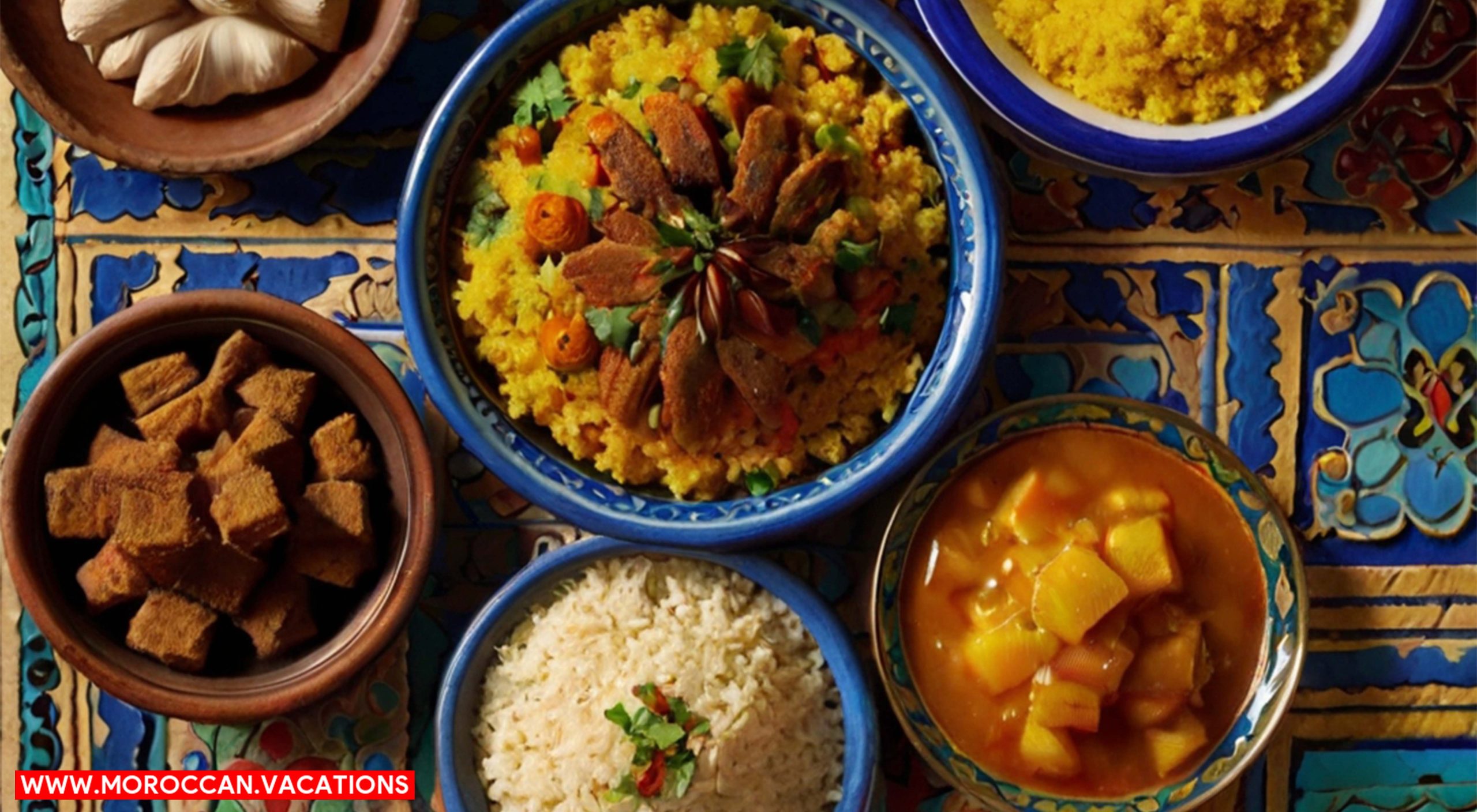

Continue your exploration of Marrakesh’s vibrant food culture by immersing yourself in traditional Moroccan recipes, from the flavorful tagines to the aromatic couscous. Traditional recipes in Morocco are deeply rooted in centuries-old cooking techniques, passed down through generations. Each dish is a celebration of the country’s rich culinary history and reflects the diverse influences of Berber, Arab, and French cultures.
To give you a taste of the traditional Moroccan cuisine, here are three iconic recipes that you can try at home:
| Dish | Ingredients | Cooking Techniques |
|---|---|---|
| Chicken Tagine | Chicken, preserved lemons, olives, onions, herbs, spices | Slow-cooked in a cone-shaped clay pot called a “tagine” to infuse the flavors and tenderize the meat. |
| Vegetable Couscous | Couscous, vegetables (carrots, zucchini, potatoes), chickpeas, raisins, spices | Steamed over the simmering broth to create fluffy grains and allow the vegetables to absorb the fragrant flavors. |
| Moroccan Mint Tea | Green tea leaves, fresh mint leaves, sugar | Boiling water is poured over the tea leaves and mint leaves multiple times to create a strong and aromatic infusion. The tea is then sweetened with sugar and served in small glasses.
Mastering the Art of Moroccan Spices and Flavors
To truly immerse yourself in the vibrant food culture of Marrakesh, you can master the art of Moroccan spices and flavors. Moroccan cuisine is known for its rich and complex flavors, which are achieved through the skillful use of spice blends and traditional cooking techniques. Here are three reasons why delving into the world of Moroccan spices and flavors will ignite your taste buds and set your culinary journey on fire:
- Aromatic Delights: The Moroccan spice blends, such as Ras el Hanout and Baharat, are a symphony of flavors that will transport you to the bustling souks of Marrakesh. The fragrant combination of spices like cumin, coriander, cinnamon, and ginger will awaken your senses and leave you craving more.
- Sensory Adventure: Moroccan cuisine is a celebration of the senses. From the vibrant colors of the spices to the tantalizing aromas that fill the air, every aspect of the cooking process is designed to create a sensory experience. By mastering the art of Moroccan spices and flavors, you will embark on a culinary adventure that will delight your taste buds and leave you with memories to savor.
- Culinary Creativity: The use of Moroccan spice blends opens up a world of culinary possibilities. Whether you’re cooking a traditional tagine or experimenting with new dishes, the flavors of Morocco will inspire your creativity in the kitchen. With a little practice and a lot of passion, you can master the art of Moroccan spices and flavors and create dishes that are truly your own.
Immerse yourself in the vibrant food culture of Marrakesh by mastering the art of Moroccan spices and flavors. Let the aromatic delights, sensory adventure, and culinary creativity take you on a journey of taste and exploration. Get ready to awaken your senses and experience the freedom of culinary expression.
Techniques and Tips for Authentic Moroccan Cooking
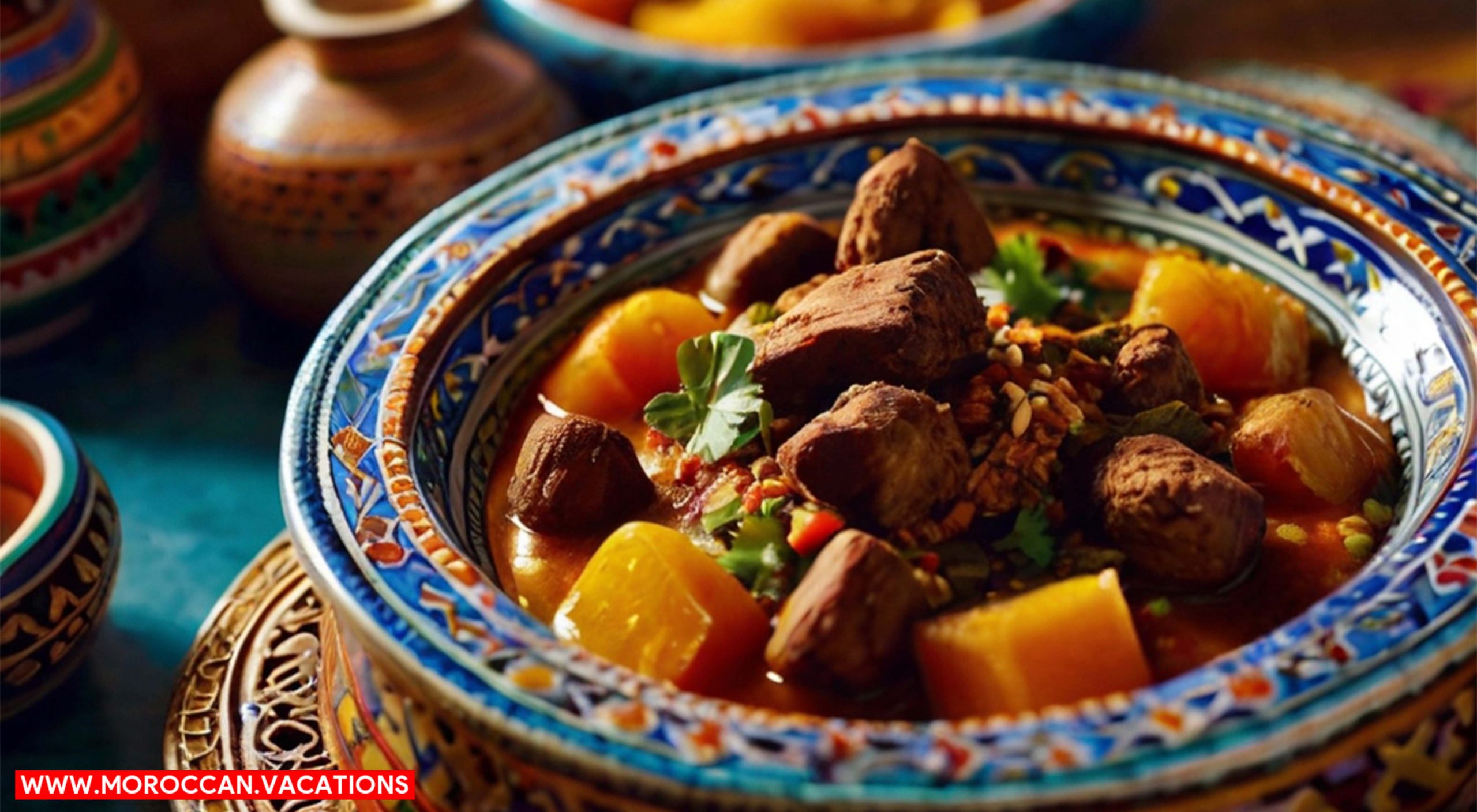

To truly master the art of authentic Moroccan cooking, you must understand the essential techniques and tips that will elevate your culinary skills. Moroccan cuisine is known for its rich flavors and aromatic spices, but it is also defined by its unique cooking methods and traditional ingredients.
One of the key cooking methods in Moroccan cuisine is slow cooking. This method allows the flavors to meld together and creates tender, succulent dishes. Tagine, a traditional Moroccan stew, is typically cooked in a clay pot with a conical lid. The slow, gentle heat of the tagine ensures that the meat and vegetables are cooked to perfection.
Another important technique in Moroccan cooking is the use of preserved lemons. These lemons are salted and pickled, and they add a tangy, zesty flavor to many dishes. They are often used in tagines, couscous, and salads.
When it comes to traditional ingredients, Moroccan cuisine relies heavily on spices such as cumin, coriander, paprika, cinnamon, and turmeric. These spices add depth and complexity to the dishes and are used in various combinations to create unique flavors.
In addition to spices, Moroccan cuisine also incorporates ingredients like olives, dates, almonds, and honey. These ingredients add a touch of sweetness and provide a contrast to the savory flavors.
Cultural Immersion: Connecting With Local Chefs and Food Enthusiasts
Connect with local chefs and food enthusiasts in Marrakesh through immersive cooking classes and culinary experiences. By connecting with the locals, you have the opportunity to experience the vibrant food culture of Marrakesh on a deeper level. Here are three ways in which you can truly immerse yourself in the local food scene:
- Exploring Local Markets: Join a local chef on a trip to the bustling markets of Marrakesh, where you can connect with the ingredients that make Moroccan cuisine so special. As you navigate through the colorful stalls, you’ll have the chance to interact with vendors, learn about traditional spices, and discover the freshest produce.
- Cooking with Local Chefs: Step into the kitchen and learn from the masters themselves. Take part in cooking classes led by skilled local chefs who will guide you through the process of preparing authentic Moroccan dishes. From tagines to couscous, you’ll not only learn the techniques but also gain an understanding of the cultural significance behind each dish.
- Sharing Meals with Food Enthusiasts: Connect with fellow food lovers and locals by joining communal dining experiences. Sit around a table filled with mouth-watering Moroccan delicacies and engage in conversations about food, culture, and life. These shared meals provide a unique opportunity to forge connections, exchange stories, and create lasting memories.


Samira Amrani
The passionate author behind Moroccan Vacations, sharing her expertise and love for Moroccan culture, cuisine, and travel experiences to inspire wanderlust in every reader.
Related Articles
Vegetarian and Vegan Options in Marrakesh Street Food
Traditional Moroccan Vegetarian Tagines Are you tired of feeling limited when it comes to finding vegetarian and vegan options in Marrakesh's bustling street food scene? Well, we've got some good news for you! Get ready to embark on a culinary adventure filled with...
Street Food Safety Tips for Enjoying Marrakesh's Local Cuisine
Research Local Food Regulations Did you know that Marrakesh is home to a vibrant street food scene, offering a rich variety of local cuisine? To fully enjoy these culinary delights while ensuring your health and safety, it's important to follow a few simple tips. In...
The Influence of Arab Cuisine on Moroccan Culinary Traditions
Historical Background of Arab Influence Imagine yourself transported to the vibrant streets of Morocco, where the tantalizing aroma of spices fills the air and the sizzle of food cooking on open flames entices your senses. In this culinary paradise, the influence of...

